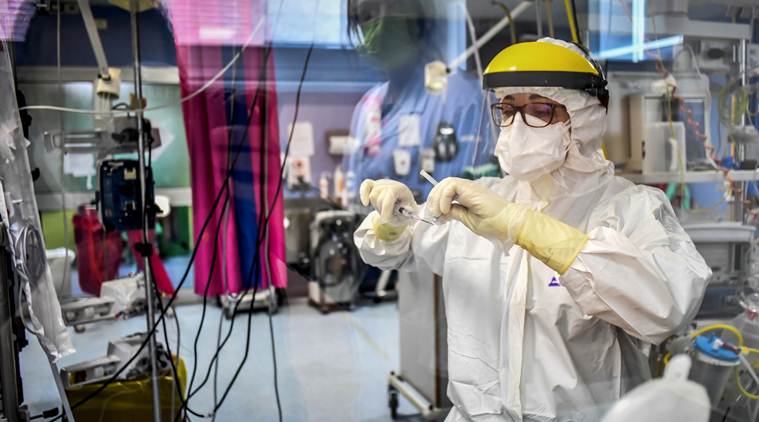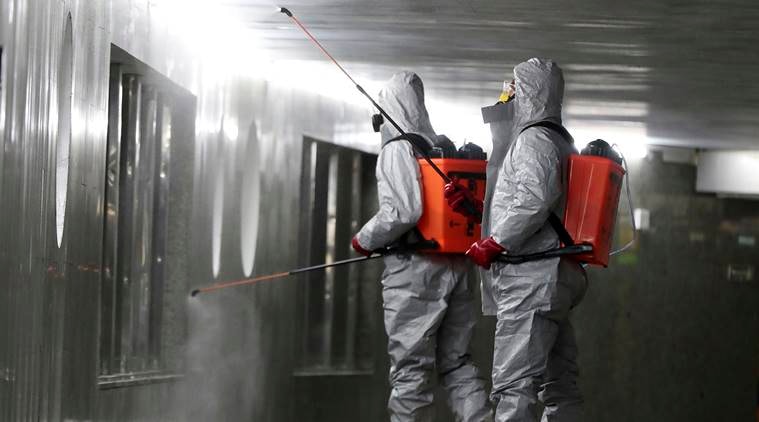Coronavirus: Globally, tally of recovered closely follows total cases, with 14-day lag
Absolute numbers on a particular date of the number of positive COVID-19 cases and recovered cases may still look intimidating. A two-week reflection, however, shows the recovery rate is trailing not too far behind the caseload.
 Medical staff work in the Intensive Care Unit of the Bassini Hospital, in Cinisello Balsamo, near Milan, Italy, Tuesday, April 7, 2020. (Claudio Furlan/LaPresse via AP)
Medical staff work in the Intensive Care Unit of the Bassini Hospital, in Cinisello Balsamo, near Milan, Italy, Tuesday, April 7, 2020. (Claudio Furlan/LaPresse via AP)
MAPPING the number of COVID-19 patients who recovered against the global case load reveals an interesting trend – it mimics the exponential growth curve of the pandemic, but also appears to closely trail the caseload, with a 14-day lag.
Absolute numbers on a particular date of the number of positive COVID-19 cases and recovered cases may still look intimidating. A two-week reflection, however, shows the recovery rate is trailing not too far behind the caseload.
For example, the Johns Hopkins database suggests 2,92,467 recovered cases Tuesday as against a global load of 1,365,004 cases. Two weeks ago, the caseload was 3,78,235, JHU statistics show.
Over a month back, March 1 saw 88,369 cases globally with only 42,716 recoveries. However, two weeks later, on March 15, there were 76,034 recoveries.
READ | Pharma majors ramp up capacity to meet demand in country and abroad

In other words, for roughly two months (from March 1 to April 6), recovered numbers grew exponentially, and clearly trailing the case load with a lag of 14 days (the incubation period).
Explaining this trend, Sitabhra Sinha, a scientist at the Institute of Mathematical Sciences in Chennai said, if everyone who fell sick on Day 1 recovered 14 days later, the two curves would exactly align. The discrepancy between the two is either people who fell sick and died, or people who recovered earlier or later than the mean period of 14 days.
Explained | Hydroxychloroquine: The drug everyone is looking at
 Workers wearing protective suits spray disinfectant at the Centrum subway station in Warsaw, Poland (AP)
Workers wearing protective suits spray disinfectant at the Centrum subway station in Warsaw, Poland (AP)
“Given that people are as likely to recover earlier as later, these two effects should balance out, so as to not affect the coincidence of the two curves by much,” he explained. “So that leaves only accounting for those who died… This is probably why the recovered curve is lower than the infected curve in your figure.”
While other pandemics might have a different duration interval between infection and recovery, “possibly one can conclude that the variability of this interval for different people is relatively low for COVID19.” Sinha has modeled a current estimated transmission rate for the country at 1.83. This means that each infected person in India is transmitting it to an average of 1.83 people.
Globally, there is considerable research on the mortality of COVID-19, there is less literature to help understand the patterns of recovery. Globally, the total deaths on Tuesday were 78,269.
There is no established recovery time of COVID-19 patients. Early World Health Organisation reports from China in late February said mild cases had a recovery time of roughly two weeks, while people with severe cases could take between three to six weeks to recover.
In a World Health Organisation briefing in early March, its executive director said a recovery is measured by a patient no longer showing symptoms and having two consecutive negative tests for the virus at least one day apart.
However, countries measure “recovery” differently. WHO does not put out global recovery rates, and without uniform methods of reporting recoveries, the number will inevitably be an estimate, according to experts. “Recovered cases outside China are estimates based on local media reports, and may be substantially lower than the true number,” states the Johns Hopkins Dashboard.
Here’s a quick Coronavirus guide from Express Explained to keep you updated: What can cause a COVID-19 patient to relapse after recovery? | COVID-19 lockdown has cleaned up the air, but this may not be good news. Here’s why | Can alternative medicine work against the coronavirus? | A five-minute test for COVID-19 has been readied, India may get it too | How India is building up defence during lockdown | Why only a fraction of those with coronavirus suffer acutely | How do healthcare workers protect themselves from getting infected? | What does it take to set up isolation wards?







